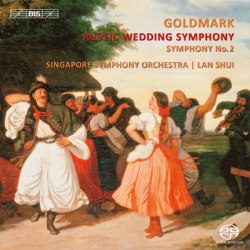|

|
Karl GOLDMARK (1830-1915)
Rustic Wedding Symphony, Op. 26 (1875) [43:46]
Symphony No. 2 in E flat major, Op. 35 (1887) [31:45]
Singapore Symphony Orchestra/Lan Shui
rec. August 2009 (Rustic Wedding), August 2011 (Symphony in E flat), Esplanade Concert Hall, Singapore
BIS  BIS-SACD-1842
[76:22] BIS-SACD-1842
[76:22]
Best known for his Rustic Wedding Symphony and the opera The Queen of Sheba (1875), Goldmark is a composer who has been less celebrated by posterity than he was during his own lifetime. However, as in all such instances, the music remains the same.
Both the symphonies featured here are undeniably attractive. The orchestration is never less than appropriate, and is often richly satisfying with plenty of colourful detail. Both pieces sound as if they must be rewarding to perform. If this is the impression that the Singapore Symphony Orchestra manage to give, then all credit to them.
Goldmark’s musical idiom sounds relatively old-fashioned for the third quarter of the 19th century, and harmonically the music offers little by way of chromatic intensity. In some respects it feels unduly safe. What it may lack in drama and challenge it makes up for in other respects. The more engaging of the two symphonies featured here is the composer’s First, entitled Rustic Wedding. Perhaps the extra-musical suggestion made by the title adds a special dimension to its personality.
The first movement is a theme and variations rather than the expected sonata-form. The time-scale is substantial, at approaching twenty minutes. The attractive theme is presented initially by the lower strings with sensitive shadings and phrasing. The movement opens and closes atmospherically. The BIS recording enhances this characteristic, allowing the musical adventures of the variations to move along in an engaging and entertaining way. The original theme is treated with great imagination, and sometimes with an unexpected complexity. The highlight of this first movement is probably the release of passionate emotion after the preceding march-presentation, while a little later, there is a marvellously sensitive elegy which Lan Shui moulds to perfection.
The Bridal Song and Serenade movements are less demanding, and here greater charm is displayed by a rival performance, by the Royal Philharmonic Orchestra conducted by Yondani Butt (ASV CDDCA791); the same orchestra also recorded it with Beecham in 1952 (review). The Andante slow movement, entitled In the Garden, has a relatively mobile tempo in Shui’s reading, adding to the music‘s fluency. Here and elsewhere the BIS recording is wonderfully warm and sensitive. If the symphony lacked the convention of a sonata-form opening movement, it has one as its finale, beginning with a fugal exposition. Details emerge clearly within the complex textures, as Shui and his orchestra move this attractive work through to an exuberant conclusion.
The Symphony in E flat major was composed twelve years later, but Goldmark’s musical style remains recognisably similar. Now the conventional four movements are organised across a shorter time-span of thirty rather than forty minutes. The musical character recalls that of Mendelssohn - nothing wrong with that - but there is no attempt to conquer the summits of the symphonic challenge as Goldmark’s Viennese contemporaries Brahms and Bruckner did. No matter, since the Singapore players bring a fresh and vital quality to their performance of this attractive work.
Terry Barfoot
 |
 |
|
